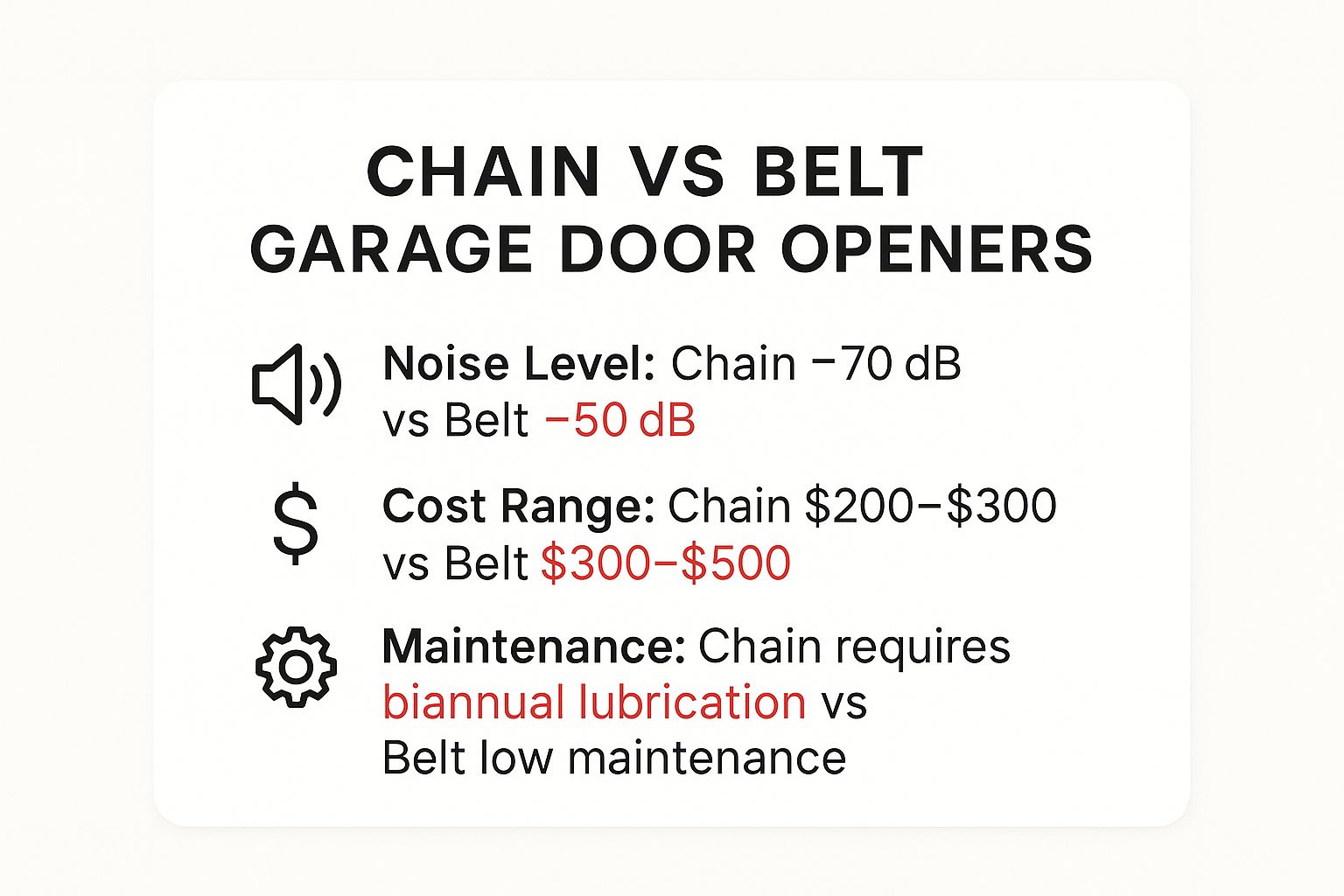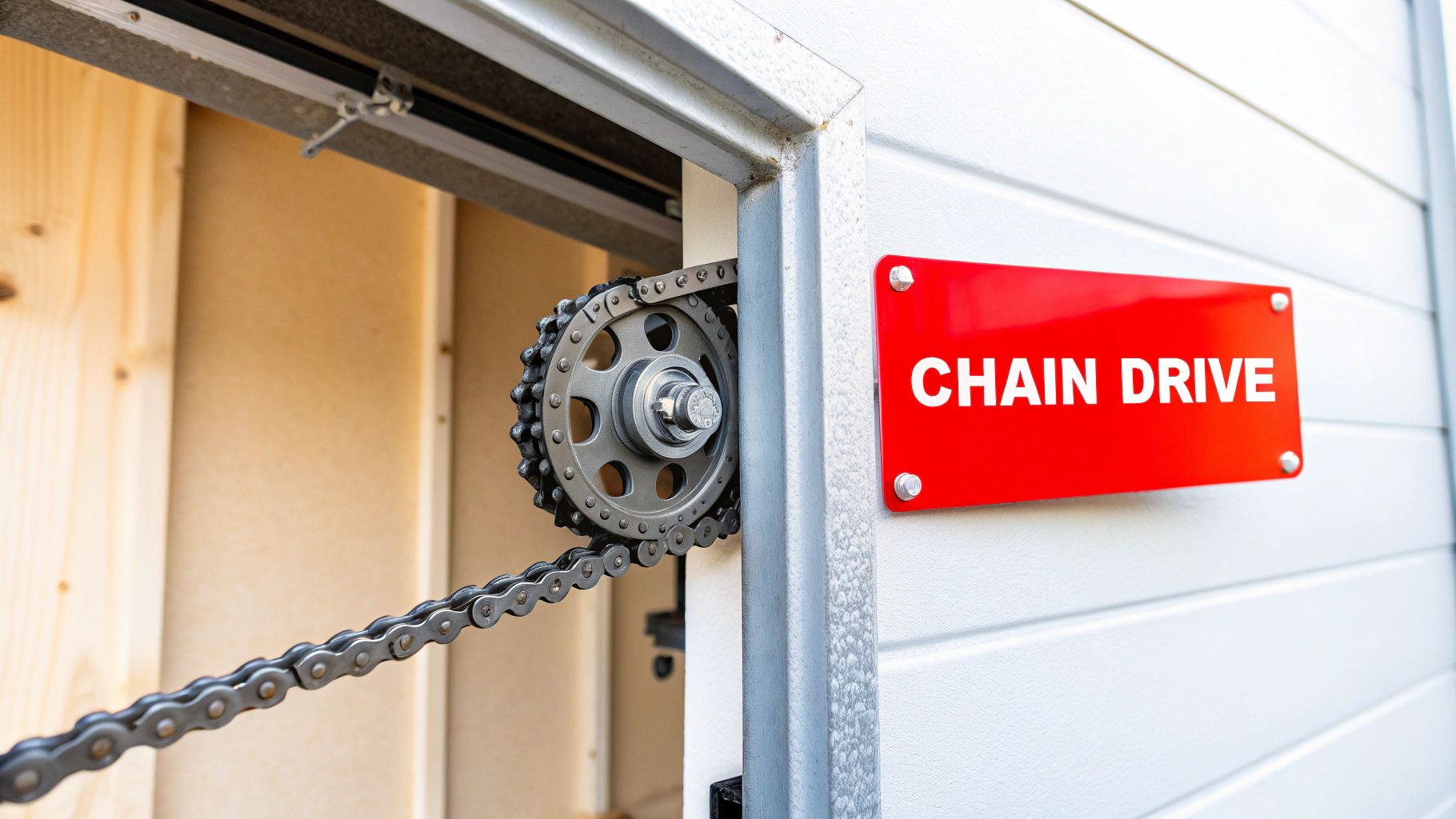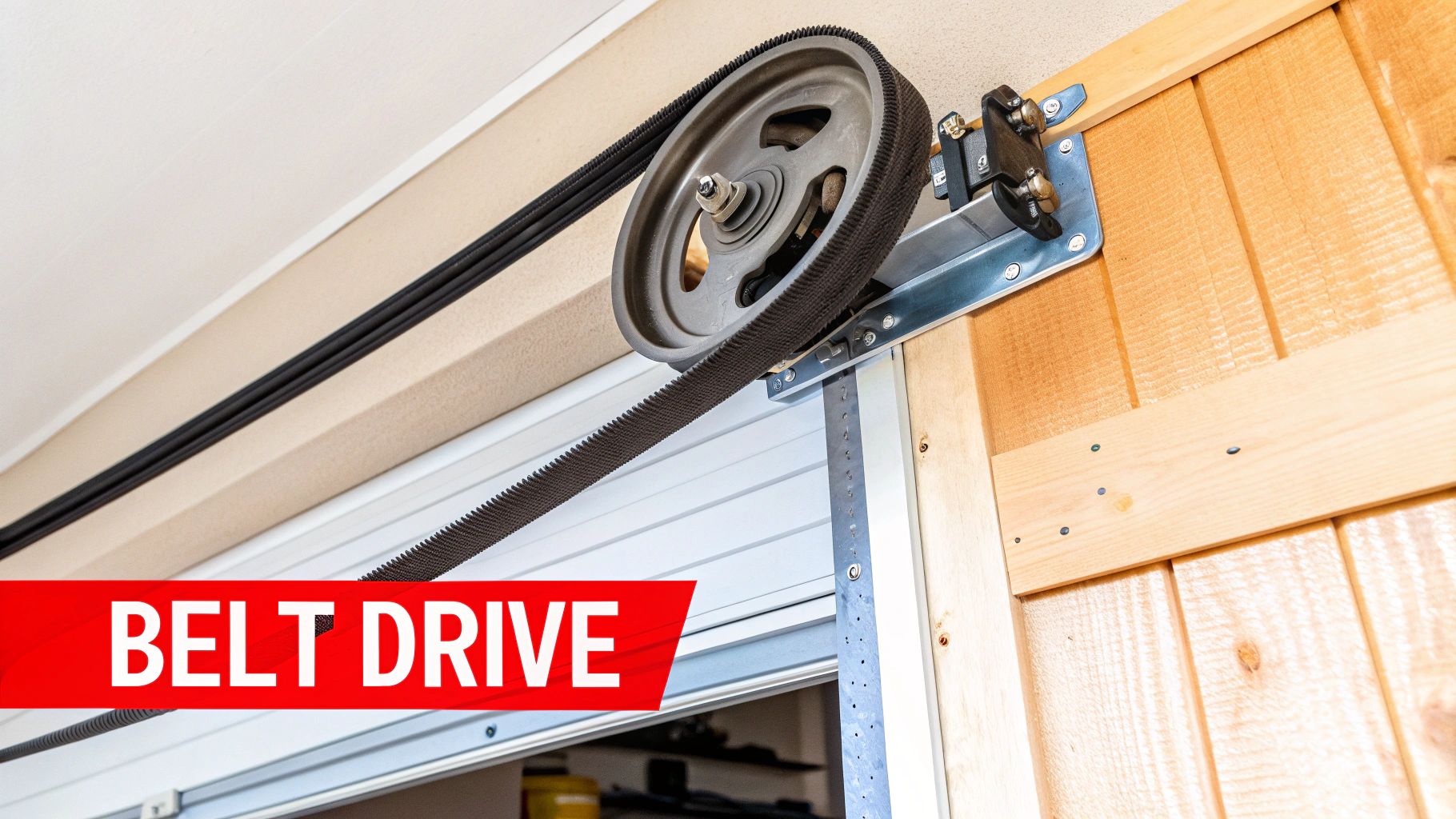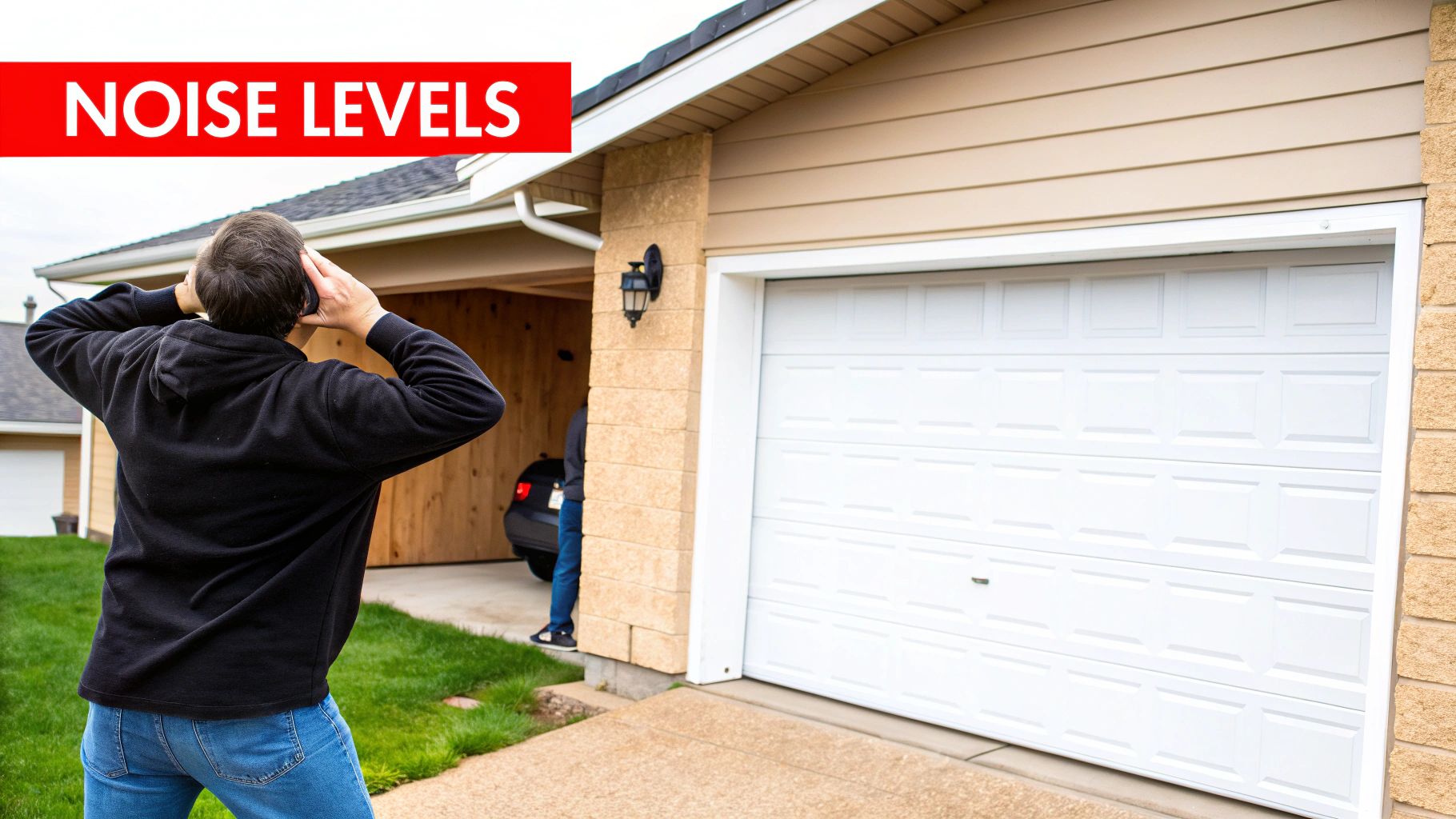When choosing between a belt drive and a chain drive for your garage door opener, the decision boils down to a critical trade-off: Is near-silent operation worth a higher initial investment, or is budget-friendly, raw power the top priority?
A belt drive opener is engineered for smooth, quiet performance, operating at decibel levels comparable to a quiet conversation. This makes it an excellent choice for homes in Texas and Oklahoma with attached garages, especially where bedrooms or living spaces are located nearby. Conversely, a chain drive opener is the industry's classic workhorse. It delivers unmatched lifting strength at a lower price point, making it the go-to for heavy, oversized doors or for detached commercial buildings where operational noise is less of a concern.
Choosing Your Garage Door Drive System
For homeowners and business owners across Texas and Oklahoma, selecting the right opener is a significant decision impacting daily convenience, security, and property value. The drive system—be it a rugged steel chain or a modern, steel-reinforced rubber belt—directly affects noise levels, maintenance requirements, and upfront costs. Understanding the core differences is the first step toward making a sound investment for your property.
This breakdown highlights the key performance metrics you'll need to consider.

While a chain drive offers immediate cost savings, a belt drive provides superior value through quieter operation and reduced long-term maintenance—a crucial factor for busy homeowners and professional environments.
Key Differences Belt vs Chain Drive Openers
To clarify the decision-making process, this table provides a side-by-side comparison of the fundamental trade-offs between belt and chain drive openers. Use these industry benchmarks to guide your initial evaluation.
| Attribute | Belt Drive Opener | Chain Drive Opener |
|---|---|---|
| Noise Level | Very Quiet (40-60 dB) | Louder (70-80 dB) |
| Best For | Attached Garages & Homes | Detached Garages & Workshops |
| Upfront Cost | Higher ($300 – $500) | Lower ($200 – $300) |
| Maintenance | Low; minimal adjustments needed | Higher; requires semi-annual lubrication |
Ultimately, both systems reliably open and close a garage door. The belt drive is a modern solution engineered for quiet comfort, explaining its rising popularity in residential settings. In contrast, the chain drive is a time-tested, durable powerhouse that remains a top choice for both budget-conscious homeowners and demanding commercial door services, prized for its sheer strength and cost-effectiveness.
If your current opener is noisy or unreliable, it might be time to consider a new garage door opener installation. However, sometimes these symptoms indicate a smaller issue that a professional residential garage door repair can resolve efficiently.
Comparing Noise Levels and Daily Operation
When weighing a belt drive against a chain drive system, the most immediate difference is sound. This is not a minor detail but a significant quality-of-life factor, particularly for properties in Texas and Oklahoma where living spaces are often adjacent to or above the garage. The distinct acoustic profile of each system is a direct result of its core materials.
A chain drive utilizes a metal chain—similar to one on a bicycle—to pull the door along its track. This metal-on-metal contact generates significant noise and vibration, creating a characteristic rattling sound that can easily transfer through a building's structure. A belt drive, however, employs a steel-reinforced rubber belt that glides smoothly and absorbs vibrations, resulting in a dramatically quieter operation.

Decibel Data: A Clear Winner for Quiet Operation
Let's quantify the difference. According to industry data, a belt drive opener typically operates between 40-60 decibels (dB), which is comparable to the ambient sound of a modern refrigerator or a quiet library.
In stark contrast, a chain drive often registers between 70 to 80 decibels—roughly equivalent to a running vacuum cleaner. This makes a belt drive opener up to 30% quieter than its chain-driven counterpart. As detailed in various garage door opener market insights, this significant noise reduction is a key driver of consumer preference in the residential sector.
Actionable Tip: For a home with a bedroom over the garage, a 75 dB chain drive can be a major sleep disruptor. For a commercial business in a shared complex, that same noise could violate lease agreements or lead to neighbor complaints. A quieter belt drive mitigates these real-world problems.
Real-World Scenarios and Practical Impact
The operational difference these noise levels create is substantial. Consider these common scenarios for property owners in Lawton, OK, or Denison, TX:
- Early Departures & Late Arrivals: A quiet belt drive allows you to come and go without waking family members or disturbing neighbors.
- Attached Living Spaces: For garages converted into home gyms, workshops, or finished rooms, a belt drive maintains a peaceful and usable environment.
- Commercial Use: In an auto repair shop or a small warehouse, reduced operational noise contributes to a safer, more focused work environment, aligning with OSHA recommendations for minimizing workplace noise pollution.
The bottom line is clear: if your garage is detached and noise is not a factor, a chain drive is a perfectly functional and economical choice. However, for anyone who prioritizes a quiet home or a professional business atmosphere, the smooth, near-silent operation of a belt drive is the superior option.
If your current opener is excessively loud, it may be time for a professional garage door opener installation of a modern, quieter model. Alternatively, extreme noise could signal the need for residential garage door repair or an inspection from our commercial door services team.
Long-Term Durability and Maintenance Demands
When evaluating the long-term value of a garage door opener, durability and maintenance are paramount. The core difference here lies in the materials—a rugged metal chain versus a steel-reinforced rubber belt. This single distinction dictates how each system withstands daily use, especially under the fluctuating weather conditions common across Texas and Oklahoma.
Chain drive openers have established their reputation on raw strength and resilience. Their all-metal construction makes them the preferred choice for lifting heavy, oversized, or solid wood doors. However, this strength requires regular maintenance to ensure a 10- to 15-year average lifespan. Without it, performance degrades quickly.
Conversely, modern belt drive openers are engineered for longevity with minimal intervention. The belts are crafted from advanced materials like polyurethane and fiberglass-reinforced rubber, making them highly resistant to the rust and corrosion that can plague a metal chain in humid climates. As a result, they frequently outlast their chain-driven counterparts, with many premium models operating reliably for 15 to 20 years.

Comparing Maintenance Schedules and Tasks
The upkeep for these two systems is fundamentally different. A chain drive demands a proactive, hands-on approach, whereas a belt drive is much closer to a "set it and forget it" solution. Understanding these maintenance obligations is crucial for protecting your investment.
Chain Drive Maintenance:
- Semi-Annual Lubrication: This is non-negotiable. The chain requires lubrication at least twice a year to reduce friction, prevent corrosion, and minimize noise. Skipping this step leads to grinding that causes premature wear on sprockets and the motor.
- Periodic Tension Adjustments: Over time, a metal chain will stretch and sag. It must be tightened periodically to prevent it from slipping off the sprocket, which can cause erratic operation or complete failure.
- Annual Debris Cleaning: The lubricant on the chain is a magnet for dust and grime. This buildup must be cleaned off to prevent it from gumming up the drive mechanism.
Belt Drive Maintenance:
- No Lubrication Required: The reinforced rubber belt operates without lubrication, eliminating a recurring and often messy task.
- Infrequent Tension Checks: While a belt may experience minimal stretching over its lifespan, it holds tension far better than a chain. Adjustments are rarely, if ever, needed.
- Visual Inspections: Maintenance typically consists of a simple visual check for signs of cracking or fraying—a rare occurrence but good practice for long-term reliability.
Industry Insight: A well-maintained chain drive is an absolute workhorse. However, our field data shows that neglected maintenance is the #1 cause of premature failure in these systems. Forgetting to lubricate the chain for just one or two seasons can dramatically shorten its operational life.
Climate Impact on Durability
For property owners in Lawton, OK, or Denison, TX, weather is a significant factor. Extreme temperature fluctuations affect materials differently. While older rubber belts could become brittle in freezing temperatures, modern belts are engineered to remain flexible. Conversely, high humidity can accelerate rust on an improperly lubricated chain.
If you are experiencing issues you suspect are related to wear and tear, our guide on common problems with garage door openers can help you diagnose the issue.
Ultimately, both systems are built to last, but their longevity is directly tied to maintenance. A belt drive offers superior durability with less effort, making it a more reliable long-term choice for most homeowners and commercial properties.
Analyzing the True Cost of Ownership
When comparing a belt drive to a chain drive, the initial purchase price is only part of the financial equation. While chain drives typically offer a lower upfront cost, a savvy property owner analyzes the total cost of ownership over the opener's full lifespan. This includes factoring in maintenance, potential repairs, and expected longevity.
A chain drive might save you $100 to $200 on the initial purchase, but that advantage can erode over time. These systems require regular lubrication and tension adjustments to prevent excessive wear. Neglecting this maintenance can lead to costly repairs, quickly offsetting the initial savings. For a busy household or a commercial operation, these maintenance costs—in both time and materials—are a tangible expense.
Belt drives, while requiring a higher initial investment, often deliver a superior return over their operational life. Their low-maintenance design translates to fewer service calls and no recurring expenses for lubricants and tune-ups.

Lifespan and Long-Term Value
The financial analysis becomes clearer when considering lifespan. A properly maintained chain drive will provide a solid 10 to 15 years of service. A quality belt drive, however, often operates reliably for 15 to 20 years. This extended longevity is due to its corrosion-resistant materials and smoother operation, which places less stress on the motor and mechanical components.
This longer operational life pushes the cost of a full replacement further into the future, making the belt drive a more economical choice over the long term. The decision evolves from a simple price comparison to a strategic investment in your property. To see how this fits into your overall budget, you can learn more about garage door installation cost trends.
Actionable Tip: A belt drive's higher initial cost is often recouped through its longer lifespan and near-zero maintenance expenses. Over a 15-year period, this can translate into significant savings on parts and professional service calls, making it a financially prudent choice for most homeowners.
Ultimately, the true cost of ownership is a balance of priorities. A chain drive is a logical choice for a detached garage where noise is not a concern and immediate budget is the primary driver. But for an attached garage or a high-traffic commercial door, the belt drive's durability and minimal upkeep present a compelling financial argument for long-term value.
Matching Opener Strength to Your Door
A common misconception is that belt drive openers are only suitable for lightweight doors. While chain drives have historically been the benchmark for power, modern belt drive technology is surprisingly robust and capable of handling the vast majority of residential doors found across Texas and Oklahoma.
The key factor is not the drive type itself, but the motor's horsepower (HP). A quality ¾ HP belt drive opener delivers more than enough torque to lift heavy insulated steel doors and even solid wood carriage-style doors. For most homeowners, this means you no longer have to sacrifice quiet operation to get the strength you need.
The critical first step is to match the opener's power to your specific door's weight and size. A properly balanced door should feel relatively light when lifted by hand, but the opener still requires adequate force to manage the daily operational load without straining the motor.
When Belt Drives Have Ample Power
For nearly all standard residential applications, a belt drive opener is perfectly capable. These systems are an excellent fit for the most common door materials and sizes.
- Standard Steel Doors: Whether single or double-car, insulated or non-insulated, a standard ½ HP or ¾ HP belt drive can operate these doors effortlessly.
- Aluminum and Fiberglass Doors: These lightweight materials pose no challenge for any belt drive system.
- Wood Composite Doors: The majority of popular wood-look doors are made from lighter composite materials, making them an ideal match for a strong belt drive.
Actionable Tip: Before selecting an opener, you must know your door's specifications. Our guide on how to measure your garage door size provides simple, step-by-step instructions. This ensures you pair the right motor with your door for safe and reliable long-term performance.
When a Chain Drive Is Non-Negotiable
While modern belt drives are impressive, certain applications demand the uncompromising brute force of a chain drive. These situations typically involve doors with extreme weight or massive dimensions.
Industry Standard: For oversized custom wood doors, industrial roll-up doors, or any door weighing over 500 lbs, a heavy-duty chain drive is the only responsible choice. This is not just a recommendation; it is a fundamental requirement for operational safety and long-term performance.
A chain drive is essential for garages with:
- Oversized or Custom Solid Wood Doors: The immense weight of a large, solid-wood door requires the raw torque that only a chain drive can consistently deliver.
- Heavy-Duty Commercial Doors: The doors on auto shops, warehouses, and agricultural buildings are larger, heavier, and endure high-cycle usage—a job that demands industrial-grade power.
- Full-View Glass Doors with Steel Frames: The combined weight of heavy glass panels and a rigid steel frame necessitates a powerful chain drive for reliable, safe operation.
Homeowner Preferences and Market Insights
The belt vs. chain debate reflects evolving homeowner priorities and lifestyle trends. In Texas and Oklahoma, we have observed a clear shift, particularly in new construction and smart home renovations. As homes become more integrated, the demand for quiet, non-disruptive technology has propelled belt-drive systems to the forefront of the residential market.
Industry data validates this trend. While chain drives still command a significant market share due to their prevalence in older homes and lower initial cost, recent garage door opener market trends show belt drives are rapidly gaining ground. They now account for 40-50% of new residential installations in North America, a figure that continues to grow annually.
Residential vs. Commercial Choices
For homeowners, the near-silent operation of a belt drive is a decisive feature. This is especially true in homes where living spaces are adjacent to or above the garage. When undertaking a major renovation, homeowners often consult a garage remodel contractor to ensure all new components, including the opener, contribute to a more modern and peaceful living environment.
In the commercial sector, however, the priorities are different. Warehouses, auto body shops, and agricultural facilities continue to rely on the raw power and proven durability of chain drives. Their ability to lift heavy, oversized doors reliably under high-cycle conditions, combined with a budget-friendly price point, makes them the undisputed workhorse for industrial applications.
Market Insight: The market is bifurcating. Homeowners are increasingly willing to pay a premium for the quiet comfort and higher perceived resale value of a belt drive. Conversely, commercial businesses prioritize the cost-effective, brute-force reliability that only a chain drive can provide.
This growing divide offers a clear takeaway. If your current opener is failing—perhaps you need a garage door spring repair to address an immediate issue—it is the perfect opportunity to assess your long-term needs. Understanding market trends can help you make a smarter investment when it's time for a full replacement.
Common Questions About Garage Door Drive Types
As you finalize your decision, a few key questions often arise. Here are expert answers to the most common queries we receive from homeowners and businesses across Texas and Oklahoma.
How Do Weather Extremes Affect These Openers?
Extreme weather absolutely impacts performance. The intense summer heat in Texas and sudden cold snaps in Oklahoma test mechanical components. While modern rubber belts are engineered to withstand these temperature swings, older or lower-quality belts could become brittle in freezing conditions.
For chain drives, high humidity is the primary concern. It can accelerate rust and corrosion on an under-lubricated chain, leading to increased noise and premature wear. Regular maintenance is the best defense against weather-related degradation for either system.
Which Drive Type Is Better for a Smart Home?
This is a common point of confusion, but the answer is simple: both drive types are fully compatible with modern smart home technology.
Leading manufacturers like LiftMaster and Chamberlain integrate Wi-Fi connectivity across their product lines for both belt and chain drive models. This allows for smartphone control, delivery monitoring, and integration with platforms like Amazon Alexa and Google Assistant. Your choice should be based on noise, durability, and cost—not smart features.
Actionable Tip: Don't let smart features dictate your choice of drive type. Focus on the core performance attributes that affect your daily life, such as noise and maintenance, as both belt and chain openers offer identical smart home capabilities.
Is a Belt Drive Easier to Install Than a Chain Drive?
The installation process is virtually identical for both systems and should always be performed by a qualified professional. While a technician may find the belt slightly lighter and cleaner to handle, the core steps—mounting the motor, aligning the rail, setting travel limits, and calibrating safety sensors—are the same.
Improper installation is a leading cause of premature opener failure and poses significant safety risks. Professional garage door opener installation is critical to ensure the system complies with UL 325 safety standards, which govern the mandatory auto-reverse safety mechanism.
If you have further questions about upgrades or repairs, our residential garage door repair and commercial door services teams can provide the expert guidance you need to make a confident decision.
